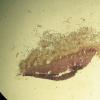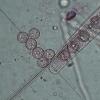
06-12-2025 00:19
 Viktorie Halasu
Viktorie Halasu
Hello, would anyone have this article, please? An

05-12-2025 17:33
 Bruno Coué
Bruno Coué
Bonjour, je serais heureux de recueillir votre avi

02-12-2025 18:59
This pair of ascos 2.5cm across were on recently b

02-12-2025 19:25
Buckwheat PeteHello, can anyone identify this hairy fungus growi

30-11-2025 12:53
 Edvin Johannesen
Edvin Johannesen
White short-stipitate apothecia found on thin twig

30-11-2025 10:47
 William Slosse
William Slosse
I recently found a collection of small Peziza sp.
Smardaea planchonis (Dunal ex Boud.) Korf & W.Y. Zhuang - to confirm
Stephen Martin Mifsud,
28-10-2018 10:26
 Hi, I found this small species in Malta which I think it is Smardaea planchonis, characterised with shallow cupulate violetish-black ascocarps growing from limestone-clayey soil close to pine trees.
Hi, I found this small species in Malta which I think it is Smardaea planchonis, characterised with shallow cupulate violetish-black ascocarps growing from limestone-clayey soil close to pine trees. Some basic features:
Ascocarps: 7-15mm wide
Ascum average size: 165.7 µm x 12.3 µm
Iodine reaction to Ascum tips: J-
Spore average size: 9 µm x 8.9 µm
The differences I observed from the type are:
- Paraphyses are sometimes lobed or even branched
- Spores a bit smaller (but within the range)
- Asci shorter
Just a question: Why I can't see the operculum? IS there a particular technique to see it or it just drops off?






